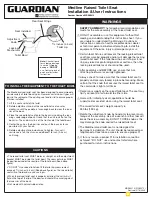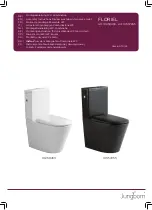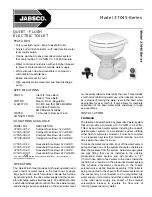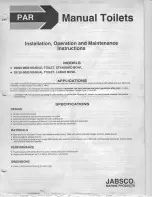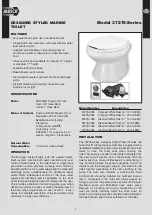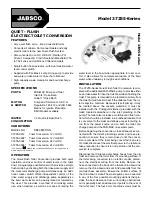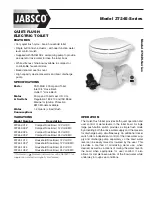
Servicing Instructions
If you plan to overhaul the toilet in the spring, this is a good time to disas-
semble it and take the components ashore to make the overhaul easier.
If you leave the toilet disassembled and, if the seacocks are opened when
the craft is afloat, water will flood in and may cause the craft to sink, which
may result in loss of life.
Therefore, you MUST attach a warning notice to the seacocks and, if pos-
sible, wire the seacocks shut.
ATTACH WARNING NOTICE!
If you are not disassembling the toilet:
•
Reconnect all hose ends and secure them with their hose
clamps.
•
Replace the base drain plug securely.
•
Replace the joker valve in the discharge elbow.
•
Reconnect the discharge elbow and hose to the cylinder using
the discharge flange, whilst relieving any leverage from the dis-
charge hose. If you do not, the joint may not seal.
•
Fasten down the seat, lid and pump handle to prevent use and
attach a warning notice.
HAZARD RISK:
Seacocks opened by mistake.
2. Servicing - Seal replacement
If water begins to leak around the piston rod (key 29) at the top of the
pump, the seal assembly (key 18) is worn and must be replaced. YOU
WILL need:
•
A Seal housing Assembly 29044-3000.
•
Unscrew the seal housing assembly (key 18) using a 24mm (15/16”)
spanner and remove the entire piston rod assembly from the toilet.
•
Wrap some tape around the piston rod within 16mm (5/8”) of the
handle. Grip the piston rod through the tape, unscrew the handle
and remove the bumper washer (key 25). Remove the tape.
•
Slide the old seal assembly off the piston rod. Wrap one turn of tape
around the thread at the top of the piston rod to protect the new
seal and slide the new seal assembly onto the piston rod. Remove
the tape from the thread.
•
Wrap some tape around the piston rod within 16mm (5/8”) of the
handle. Grip the piston rod through the tape and replace the bump-
er washer and handle. Remove the tape from the piston rod.
•
Slide the whole assembly back into the pump cylinder and tighten
in place.
Remove the pump assembly as follows:
•
Loosen hose clamps; disconnect the inlet hose and the flushing wa-
ter hose (key 4) from the top of the pump.
•
Remove the 2 screws (key 31) that secure the discharge flange (key
32) that holds the discharge elbow (key 34) and hose to the pump
cylinder (key 28).
•
Do NOT remove the hose from the discharge elbow.
•
Remove the 4 screws (key 31) that secure the pump cylinder to the
base.
•
Lift off the pump assembly and pick up the base valve gasket (key
16) and the joker valve (key 33).
4. Servicing - Overhaul
YOU WILL need:
•
A Service Kit, part number 29045-3000, which contains all wearing
parts - refer to the PARTS LIST for details.
5. Servicing - Testing
REFER to the OPERATING INSTRUCTIONS and follow the procedure for
“2. Normal use”.
•
If the flushing pump is hard to prime, half-fill the bowl with fresh wa-
ter.
ON COMPLETION OF SERVICING:
•
SHUT ( ) THE FLUSH CONTROL
•
CLOSE BOTH SEACOCKS.
Dismantle the pump assembly as follows:
•
Remove the 6 screws (key 26) that secure the valve cover (key 27).
•
Open ( ) the Flush Control (key 23) before lifting off the valve
cover assembly and picking up the top valve gasket (key 21), the
valve seat (key 19) and the valve spring (key 35).
•
Remove the handle and the seal assembly by following the SERVIC-
ING INSTRUCTIONS for SEAL REPLACEMENT.
•
Withdraw the piston assembly (key 29) and prise off the piston
O-ring (key 30).
•
Do NOT remove the bowl from the base
•
Clean and disinfect all parts - refer to OPERATING INSTRUCTIONS
for CLEANING. Remove scale from the cylinder bore.
•
Inspect the top and bottom valve gaskets (key 21) and the jok-
er valve, and renew them if they are damaged, stiff or covered
with scale. Automatically renew the seal assembly and the piston
O-ring. Use the other parts in the kit as necessary.
Reassemble the pump as follows:
•
Push on the new O-ring (key 30) and lubricate with silicon lu-
bricant.
•
Following the SERVICING INSTRUCTIONS for SEAL REPLACE-
MENT fit the new seal assembly (key 18), the piston assembly
(key 29) and the handle (key 17).
•
Lubricate pump cylinder bore with silicon lubricant.
•
Locate the valve seat (key 19) on top of the cylinder, locate the
top valve gasket (key 21) on its pegs on top of the cylinder,
locate the valve spring (key 35) on its peg in the valve cover,
and Open ( ) the Flush Control (key 23) before refitting
the valve cover (key 27).
•
Locate the joker valve (key 33) in the discharge elbow (key 34).
•
Secure the discharge elbow and hose to the cylinder, using the
discharge flange (key 32), BEFORE you refit the pump assem-
bly to the base (key 7), so that the joint is not under leverage
from the discharge hose. If you do not, the joint may not seal.
•
Locate the bottom valve gasket (key 16) on its pegs on the
base.
•
Secure the pump assembly to the base whilst relieving any lev-
erage from the discharge hose. If you do not, the joint may
not seal.
•
Examine all hoses throughout their length for chafe, kinks and
splits under hose clips. Check all hose clamps for corrosion
and replace worn or damaged parts.
•
Reconnect all loose hose ends and secure them with their hose
clamps.
•
Ensure that the base drain plug (key 8) is securely in place.
3. Servicing - Winterisation
Drain the complete system, both as protection against frost dam-
age and to discourage the growth in the pipework of anaerobic
bacteria that cause unpleasant smells.
•
Open any secondary valves.
•
Remove the base drain plug (key 8).
•
Disconnect the discharge flange (key 32) from the pump (avoiding
the need to remove the hose from the discharge elbow (key 34).
•
Loosen hose clips and disconnect the hose ends from both seacock
hose tails. Pump the handle (key 17) to drain the toilet pump and
ensure that all water is drained from the toilet system.
CAUTION:
Gripping the piston rod with a tool
anywhere except on the 16mm (5/8”) below the
handle damages the surface in a way that causes
rapid seal failure.
CAUTION:
The use of anti-freeze is NOT
RECOMMENDED, as it is impossible to ensure that
it penetrates the complete toilet system. If, for any
reason, anti-freeze is used it MUST be glycol based.
CAUTION:
Do NOT lubricate top or bottom valve
gaskets. Do NOT apply sealing compounds to any
gaskets or hose connections.
6









